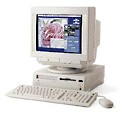This column was first published in the MUGOO Newsletter
in June 2000.
I was thrilled to have my
Mac when I brought it home in 1994. Gee whiz, 5 megs of RAM, System
7.1.2P, a 68LC040  chip, a 250 megabyte hard drive,
Claris Works 2.0, and Quicken 4 - not to mention a 9600 baud modem.
Wow!
chip, a 250 megabyte hard drive,
Claris Works 2.0, and Quicken 4 - not to mention a 9600 baud modem.
Wow!
Boy, looking back at those heady days, it seem so long ago - now
that I have 36 megs of RAM, 8.1 OS, a 68040 processor, a 4 gig hard
drive, AppleWorks 5.0, and Quicken 2000. The path from old Performa to
new Performa had several loops, dead ends, and plenty of lessons
learned from upgrading hardware and software. What made it successful
was being resourceful, having a willingness to learn, and focusing on
requirements, not desires.
When there were problems along the way, it was the result of a
serious bout of LAGS (Latest and Greatest Syndrome) and CPU envy.
Lessons learned are: Make sure that hardware is adequate for software;
Plan the upgrade and the tradeoffs; and Patience, patience, patience.
Now a walk into the past
Software Upgrade/Hardware Upgrade Tango
The first upgrade was upgrading my operating system from System
7.1.2P to 7.5. This was the first of several OS upgrades. The process
went smoothly. All my old applications worked fine, and I downloaded
the subsequent 7.5.3 and 7.5.5 releases. There were no problems running
old applications under System 7.5; the problem was that my machine kept
crashing from insufficient memory! It turned out while 7.5 ran on my
Performa with 5 MB of RAM, 8 MB was the recommended minimum. There were
two solutions at the time; upgrade RAM by installing an 8, 16, or 32 MB
SIMM or choose the software solution.
Apple technical support recommended the hardware solution. It was,
in fact, more than a recommendation; it was policy. Apple support was
noncommittal regarding how a software solution, like RAM Doubler, would
work. Well, it seemed clear: Buy the SIMM, and don't take a chance on a
software solution. The next factor to consider was cost.
At the time, RAM was $25 a MB; a 8 MB SIMM would cost $200. RAM
Doubler was $50. The question now became, do I tradeoff quality and the
sanctioned solution or go with the unknown quality, low cost, and
questionable solution? I opted for the less costly route by installing
RAM Doubler. Now may machine ran as though it had 10 MB of RAM.
The choice for RAM Doubler was reasonable. Nearly all my crashes
were eliminated, and my applications ran well. There was another
tradeoff, though, in performance. My Mac now seemed to run slower,
because, in fact, it was running slower. The virtual memory scheme
which RAM Doubler employed came at the expense of speed. Fair is fair,
though, and I saved $150.
Next Time: Resources and Upgrading by a
Weekend Warrior, Part 2, or 7.6 to 8.1: only megabytes from
success.

 chip, a 250 megabyte hard drive,
Claris Works 2.0, and Quicken 4 - not to mention a 9600 baud modem.
Wow!
chip, a 250 megabyte hard drive,
Claris Works 2.0, and Quicken 4 - not to mention a 9600 baud modem.
Wow!
